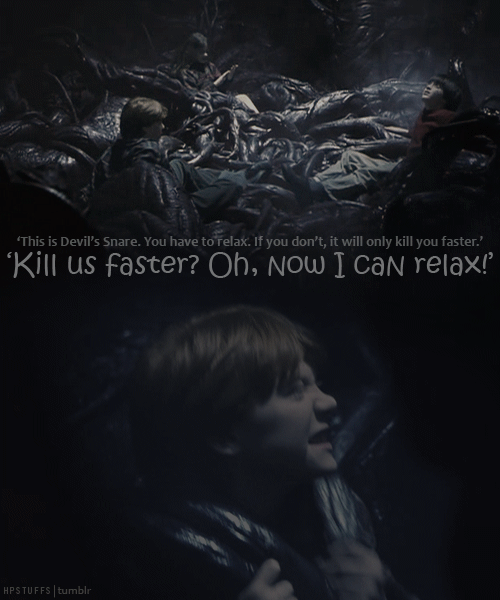*I do not own Harry Potter, therefore, mention of characters/concepts are solely intended for educational and therapeutic gain.*
What is Devil’s Snare and how does it relate to panic attacks?
Devil’s snare is a magical plant introduced in Harry Potter and the Sorcerer’s/Philosopher’s Stone. The plants look like vines with springy tendrils. They can be deadly because they are known to ensnare people when touched. Much like a boa constrictor, they will bind your arms and legs to choke you. Naturally, the first reaction to being ensnared by this deadly plant is to thrash around and fight to get free. However, fighting the devil’s snare is the worst thing a person can do because that causes the plant to squeeze tighter and kill faster.
Panic attacks are intense episodes of anxiety characterized by symptoms of sweating, trembling/shaking, shortness of breath/feeling smothered, racing heart, chest pain, sensation of choking, nausea, light-headedness, tingly, dizzy, numbness, loss of touch with reality, feeling detached from yourself, feeling you are losing control, having a heart attack, or dying. Most panic attacks last for 15 to 20 minutes. Despite how panic attacks feel, they can not actually cause death unless if you are having one while doing something dangerous. Some individuals experience just one or two in their life and do not need treatment for them. Others experience regular panic attacks and will often develop a fear of having panic attacks, thus triggering more panic attacks to occur (also known as panic disorder). Additionally, individuals often avoid various stimuli or experiences in order to prevent panic attacks, however, in so doing, seriously limit life experiences or create more problems.
It seems as though the sensation of being ensnared by devil’s snare mimics the physiological symptoms and thoughts occurring during a panic attack. Furthermore, the more one attempts to stave off or stop a panic attack, the worse it gets. In the movie version of Harry Potter and the Sorcerer’s Stone, Devil’s snare will release you if you relax and stop struggling against it. Similarly, when you stop fighting a panic attack and let go it will subside faster. Another way to defeat devil’s snare is to use sunlight (movie version) or fire (blue flame spell), because they prefer a dark and damp environment. In the muggle world sunlight and feeling warm represents pleasant feelings, and could be helpful to think of when struggling with anxiety.
Exercises for panic attack relief
It is not your job to stop a panic attack once it has already started. The best thing you can do is take away the power is has over you. If you welcomed your panic attacks like an old friend then they would likely stop occurring. While it might feel unnatural to relax your body when you are smothered by a panic attack, it is the best way to shorten the duration.
Try the following visualization exercise:
Imagine you have escaped Fluffy (Hagrid’s three-headed dog) in the forbidden corridor and have just jumped into a dark trap door. You are unable to see anything as you fall. Suddenly you collide with a springy vine-like material. Initially, it cushions and supports you in a comforting way. But suddenly you realize that strong tendrils are slowly wrapping around your arms and legs. As soon as you realize what is happening, it is already too late. You are now unable to move and feel panicked. Your palms and underarms become sweaty as you overheat. You begin to hyperventilate and struggle to catch your breath. Your heart is racing and your fingers are trembling. You begin to feel light-headed and wonder if this is real life. You worry that you are trapped and dying. As you have these thoughts and struggle against your bonds you feel the vines tightening over you. You are choking and your lungs feel like they are being crushed. Suddenly you remember Professor Sprout, your Herbology professor. You can hear her lecture in your memory: “Devil’s snare will loosen it’s hold on you if you relax. It also hates sunlight and fire. It likes to be in a cool damp place”.
Mustering all of your courage, you focus on relaxing your body starting from head to toe. You feel tension in your head and you slowly release it. Then you focus on your neck, tensing and releasing those muscles until they feel relaxed. Then move on to your shoulders, squeeze as hard as you can and then release. Move down to your underarms, back, lower back, abdomen, hips, thighs, knees, calves, shins, heels of your feet, arches, and then toes. Imagine the feeling of sun rays beaming down on you, making you feel warm and soothed. With a clearer head you realize that you can easily solve your problem. You grab your wand and recite the incantation, “Lumos Solem”. A jet of sunlight streams from the wand and a bright light bursts through the dark room. You can hear the faintest scream of the devil’s snare before it shrinks away, releasing the tendrils ensnared over your body. You feel a weight lift off of you and your body is now the lightest and calmest you have ever felt.
Journaling Questions
It is recommended to process the visualization exercise above using the following questions.
- How did the visualization of devil’s snare wrapping around you compare to the physiological sensations during a panic attack?
- How did it compare to the thoughts you have while having a panic attack?
- When you have panic attacks do you usually try to fight them off and resist or do you welcome them and allow them to run their course?
- What happens if you try to resist and fight off the panic attacks?
- Ponder this sentence: You have more control when you relinquish your control. What do you think that means?
- Similarly to Hermione’s response to the devil’s snare, the only way to be freed is to let go (even though it feels hard or even counterintuitive to do that). In so doing, you regain your power over the situation. When panic attacks are no longer considered as a threat or fear (perhaps more like an inconvenience instead), then you will find that they do not occur as often and last for a much shorter duration. This is an example of a paradoxical intervention (doing the opposite in order to reach the intended result).
Please note that these therapy exercises do not qualify as stand-alone treatments and it is recommended that you seek help from a licensed professional mental health provider.
Contact me with questions or to schedule an appointment:
E-Mail: jmorrismhc@gmail.com
Voicemail: (248) 327-4643










Recent Comments